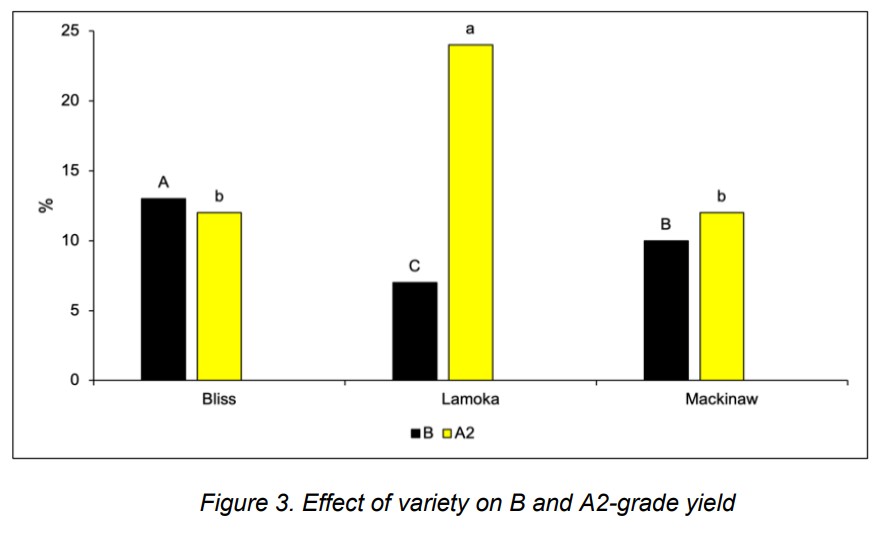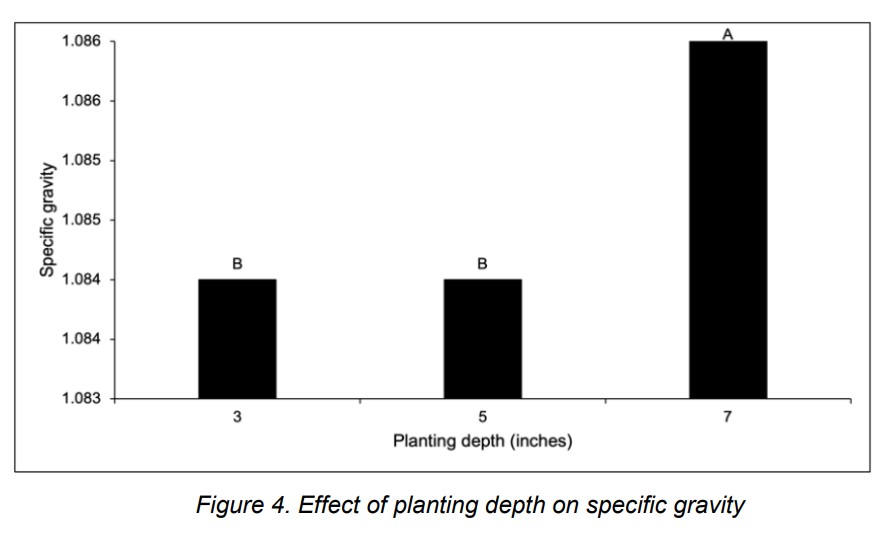
2024 Potato Seed Spacing and Planting Depth: An Agronomic Analysis
DOWNLOADApril 3, 2025 - Steve Whittington, Phabian Makokha, Chris Long, Stephanie Kipp
Introduction
Michigan is among the top ten potato producing states in the United States with a large component of the Michigan Potato Industry dedicated to supplying potatoes for nationwide chip manufacturers. Michigan State University (MSU) has invested decades into advancing potato variety development to support and strengthen the industry. These varieties are developed in order to: increase climatic resilience, improve agronomic traits, and to improve processing quality for the potato processing industry.
However, even after varieties are developed to meet specific agronomic traits, the optimal growing practices to maximize yield and profitability for the new released varieties are generally unknown. It takes about 5 to 7 years of commercial production to develop the best production practices for a new variety. The key agronomic factors influencing potato yield and quality include plant spacing and depth which can vary based on variety for optimal productivity. Therefore, research to understand the optimal field management practices for each variety is necessary to achieve optimal yield and quality. MSU Extension specialists and educators, local producers, and the Michigan Potato Industry commission partnered and designed a three-year research study to identify the optimal seed spacing and planting depth for two newly released varieties: Mackinaw and Bliss.
Trial Procedure – Year 1
The study was conducted at MSU Montcalm Research Center in Lakeview, MI, between May and September 2024. Treatments included two newly released varieties Bliss and Mackinaw, as well as an older variety, Lamoka. Four in-row spacings were used: 7-, 9-, 11-, and 13-inches, with 9-inch as the standard industry practice. Planting depths were 3-, 5-, and 7-inches, with 5-inch as the industry standard. The trial was set up as a randomized complete block design with four replicates. Trial plots consisted of three-row plots with each row measuring 15 feet long and 2.8 feet wide. Certified potato seed was cut by hand to an average seed piece of 2.5 oz and treated with CruiserMaxx Vibrance® and suberized for one week at 50oF prior to planting.
The trial was planted on May 13 and 14, 2024. A two-row-assist-feed planter was used to open rows. The potato planters’ covering discs were set to avoid covering the furrows, allowing furrows to remain open. Seed pieces were hand planted using trowels with vertical marked distances to estimate the planting depths during seed placement. All other agronomic practices followed local grower practices as recommended by MSU Extension for commercial potato production. Vines were killed at 112 days after planting (DAP) and harvest was at 134 DAP.
In-season data were collected on stand emergence, stem number, vine vigor, and vine maturity. Post-harvest assessments included total and US#1 yield, tuber size distribution, specific gravity, and internal tuber traits. The US#1 yield comprised of A1, A2, and oversize tuber yield. Tuber sizes were categorized as B grade (< 17/8’’), A1 grade (17/8’’- 25/8), A2 grade (25/8 – 31/4), over-size (>31/4), and culls. Analyses of variance was done using SAS software and means separated by LSD at 5% confidence level.
Preliminary Results
The fact sheet presents results on tuber yield, tuber size distribution, and specific gravity. Seed spacing statistically influenced total and US#1 yield, as well as tuber size distribution for B and A2 grade yield. Variety statistically affected B and A2-grade yield while planting depth affected specific gravity. Over size, culls, and internal tuber traits were not statistically affected by any of the effects. Both seed spacing, variety, and planting depth affected tuber yield, tuber size distribution, and specific gravity independently. All other effects evaluated did not show significance on the parameters reported.
Total yield and US#1 yield
Total and US#1 yield increased with closer seed spacing (Figure 1). The 7-inch seed spacing produced the highest total yield compared to 9, 11, and 13-inch seed spacing. Additionally, the 7-inch seed spacing demonstrated higher US#1 yield compared to 11 and 13-inch, but similar to 9-inch seed spacing.
Tuber size distribution
The percentage of B-grade yield increased with closer seed spacing (Figure 2). The closest seed spacing of 7-inches demonstrated the highest yield of B-grade potatoes, compared to 9, 11, and 13-inch. In contrast, the percentage of A2 tuber yield increased with wider seed spacing. Seed spacings of 11 or 13-inches demonstrated the highest A2 tuber yield compared to 7 and 9-inch seed spacings.
Effect of variety on B-grade and A2-grade yield
Bliss had higher percentage of B-grade yield, while Mackinaw demonstrated an intermediate yield among the three varieties (Figure 3.) Both Bliss and Mackinaw had similar A2 tuber yield.

Effect of planting depth on specific gravity
The specific gravity of tubers is used as a measure of quality for processing potatoes as it estimates the dry matter content in tubers. A higher amount of dry matter results in a higher specific gravity, which is desireable in the potato processing industry. The results indicated higher specific gravity at the deepest planting depth (Figure 4). The 7-inch planting depth showed highest specific gravity compared to shallow planting depths of 3 and 5-inches. The cooler temperatures (results not shown) at greater depth may be the reason for increased specific gravity.

Preliminary Conclusions
Our initial findings suggest that a closer seed spacing of 7-inches may increase total yield for Bliss and Mackinaw and improve US#1 yield compared to wider spacings of 11 and 13-inches. However, 7-inch seed spacing had similar US#1 yield as 9-inch seed spacing. Seed spacing also influenced the distribution of B and A2-grade yield among the varieties. A deeper planting depth of 7-inches demonstrated higher specific gravity. Our results also showed that seed spacing and planting depth affected total and US#1 yield independently.
It is important to note that these results are based on one year of data and are not conclusive. Further analysis in subsequent years will provide a clearer understanding of these trends. While closer seed spacing may enhance yield, it also increases seed costs due to higher plant plant populations. We therefore conducted an economic analysis associated with increased seeding rates with findings presented in an additional economics factsheet that will highlight various economic implications of the research. Additionally, studies on optimal moisture and nutrient management, as well as pest and disease risks under higher seeding rates would be valuable information in order to further refine best practices of seed spacing and depth research.
MSU is an affirmative-action, equal-opportunity employer, committed to achieving excellence through a diverse workforce and inclusive culture that encourages all people to reach their full potential. Michigan State University Extension programs and materials are open to all without regard to race, color, national origin, gender, gender identity, religion, age, height, weight, disability, political beliefs, sexual orientation, marital status, family status or veteran status. Issued in furtherance of MSU Extension work, acts of May 8 and June 30, 1914, in cooperation with the U.S. Department of Agriculture. Quentin Tyler, Director, MSU Extension, East Lansing, MI 48824. This information is for educational purposes only. Reference to commercial products or trade names does not imply endorsement by MSU Extension or bias against those not mentioned.



 Print
Print Email
Email
